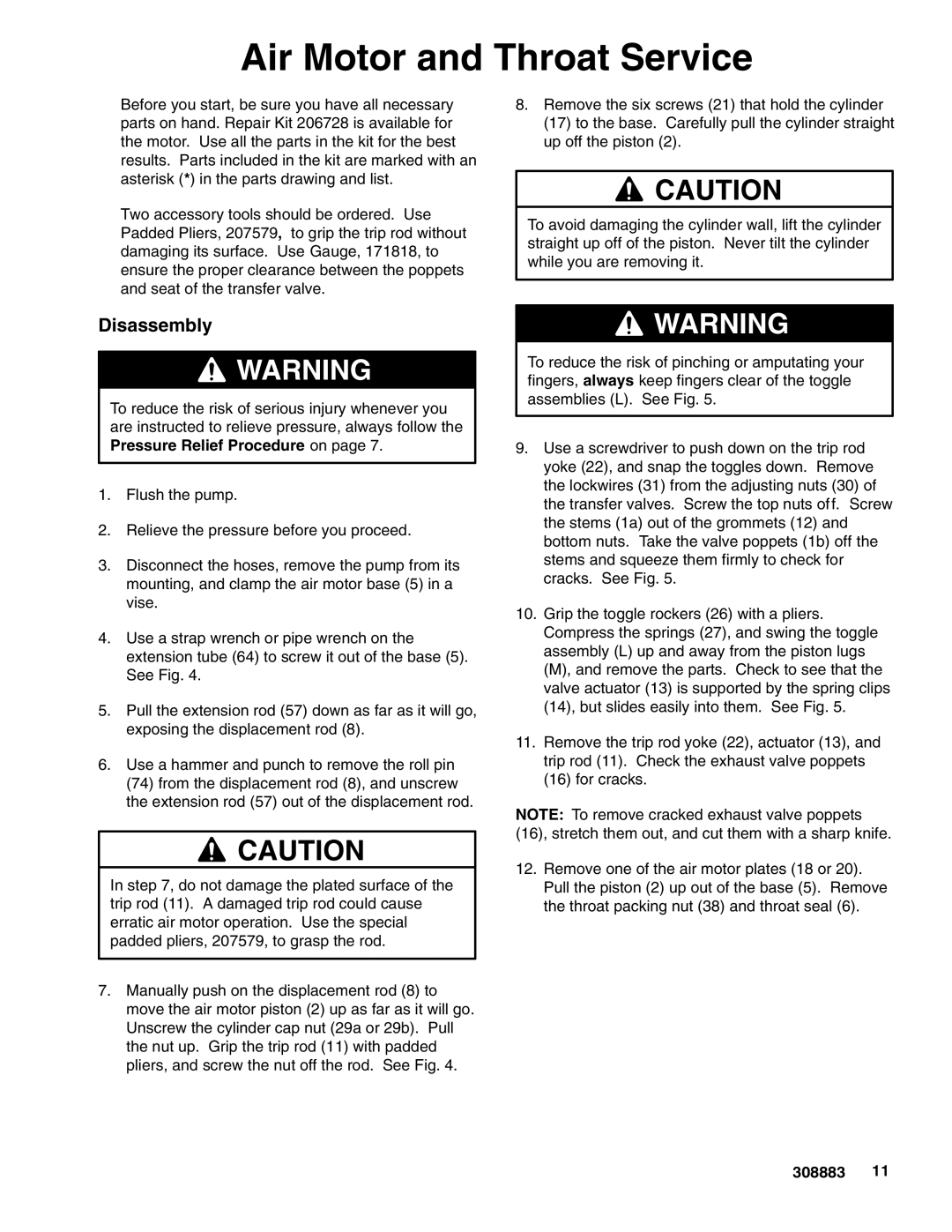
Air Motor and Throat Service
DBefore you start, be sure you have all necessary parts on hand. Repair Kit 206728 is available for the motor. Use all the parts in the kit for the best results. Parts included in the kit are marked with an asterisk (*) in the parts drawing and list.
DTwo accessory tools should be ordered. Use Padded Pliers, 207579, to grip the trip rod without damaging its surface. Use Gauge, 171818, to ensure the proper clearance between the poppets and seat of the transfer valve.
Disassembly
WARNING
To reduce the risk of serious injury whenever you are instructed to relieve pressure, always follow the Pressure Relief Procedure on page 7.
1.Flush the pump.
2.Relieve the pressure before you proceed.
3.Disconnect the hoses, remove the pump from its mounting, and clamp the air motor base (5) in a vise.
4.Use a strap wrench or pipe wrench on the extension tube (64) to screw it out of the base (5). See Fig. 4.
5.Pull the extension rod (57) down as far as it will go, exposing the displacement rod (8).
6.Use a hammer and punch to remove the roll pin (74) from the displacement rod (8), and unscrew the extension rod (57) out of the displacement rod.
![]() CAUTION
CAUTION
In step 7, do not damage the plated surface of the trip rod (11). A damaged trip rod could cause erratic air motor operation. Use the special padded pliers, 207579, to grasp the rod.
7.Manually push on the displacement rod (8) to move the air motor piston (2) up as far as it will go. Unscrew the cylinder cap nut (29a or 29b). Pull the nut up. Grip the trip rod (11) with padded pliers, and screw the nut off the rod. See Fig. 4.
8.Remove the six screws (21) that hold the cylinder (17) to the base. Carefully pull the cylinder straight up off the piston (2).
![]() CAUTION
CAUTION
To avoid damaging the cylinder wall, lift the cylinder straight up off of the piston. Never tilt the cylinder while you are removing it.
![]() WARNING
WARNING
To reduce the risk of pinching or amputating your fingers, always keep fingers clear of the toggle assemblies (L). See Fig. 5.
9.Use a screwdriver to push down on the trip rod yoke (22), and snap the toggles down. Remove the lockwires (31) from the adjusting nuts (30) of the transfer valves. Screw the top nuts off. Screw the stems (1a) out of the grommets (12) and bottom nuts. Take the valve poppets (1b) off the stems and squeeze them firmly to check for cracks. See Fig. 5.
10.Grip the toggle rockers (26) with a pliers. Compress the springs (27), and swing the toggle assembly (L) up and away from the piston lugs (M), and remove the parts. Check to see that the valve actuator (13) is supported by the spring clips (14), but slides easily into them. See Fig. 5.
11.Remove the trip rod yoke (22), actuator (13), and trip rod (11). Check the exhaust valve poppets (16) for cracks.
NOTE: To remove cracked exhaust valve poppets (16), stretch them out, and cut them with a sharp knife.
12.Remove one of the air motor plates (18 or 20). Pull the piston (2) up out of the base (5). Remove the throat packing nut (38) and throat seal (6).
308883 11
